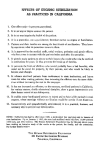Sterilized in the name of public health: race, immigration, and reproductive control in modern California
- PMID: 15983269
- PMCID: PMC1449330
- DOI: 10.2105/AJPH.2004.041608
Sterilized in the name of public health: race, immigration, and reproductive control in modern California
Abstract
In exploring the history of involuntary sterilization in California, I connect the approximately 20,000 operations performed on patients in state institutions between 1909 and 1979 to the federally funded procedures carried out at a Los Angeles County hospital in the early 1970s. Highlighting the confluence of factors that facilitated widespread sterilization abuse in the early 1970s, I trace prosterilization arguments predicated on the protection of public health. This historical overview raises important questions about the legacy of eugenics in contemporary California and relates the past to recent developments in health care delivery and genetic screening.
Figures


Comment in
-
In the name of public health.Am J Public Health. 2005 Jul;95(7):1095-7. doi: 10.2105/AJPH.2004.058065. Epub 2005 Jun 2. Am J Public Health. 2005. PMID: 15933231 Free PMC article. No abstract available.
References
-
- Art Torres to Edmund G. Brown, Jr., September 7, 1979, Legislative History, Assembly Bill 1204, Microfilm 3:3 (57), California State Archives (CSA).
-
- “Enrolled Bill Report,” August 31, 1979, Legislative History, Assembly Bill 1204, Microfilm 3:3 (57), CSA; California’s Compulsory Sterilization Policies, 1909–1979, Lisa M. Matocq, ed. (Sacramento, Calif: Senate Publications; December 2003).
-
- Author’s interview with Art Torres, November 17, 2003, San Francisco, Calif.
-
- These studies often focused on poor rural White families. See Nicole Hahn Rafter, White Trash: The Eugenic Family Studies, 1877–1919 (Boston: Northeastern University Press, 1988).
-
- Several weeks before California, the state of Washington passed the second sterilization law in the country. See Harry H. Laughlin, Eugenical Sterilization in the United States (Chicago: Psychopathic Laboratory of the Municipal Court, 1922).
Publication types
MeSH terms
LinkOut - more resources
Full Text Sources
Medical
Miscellaneous

